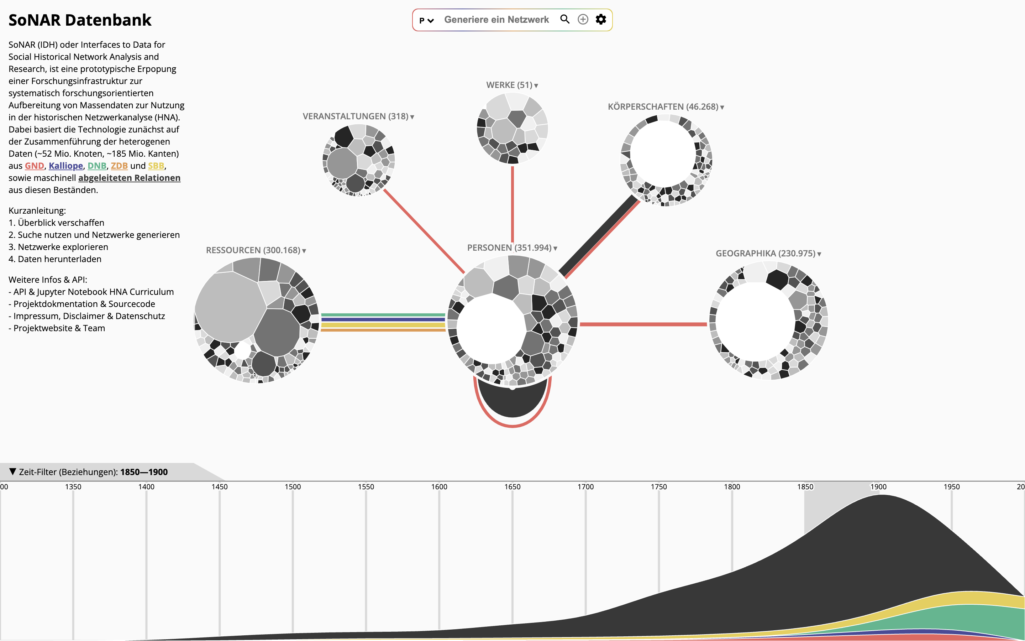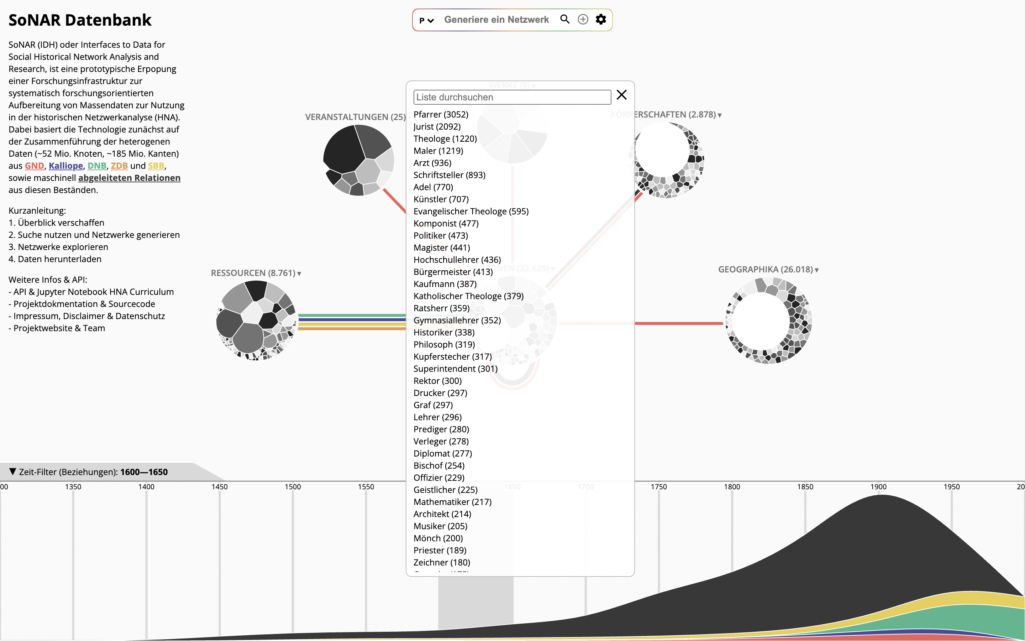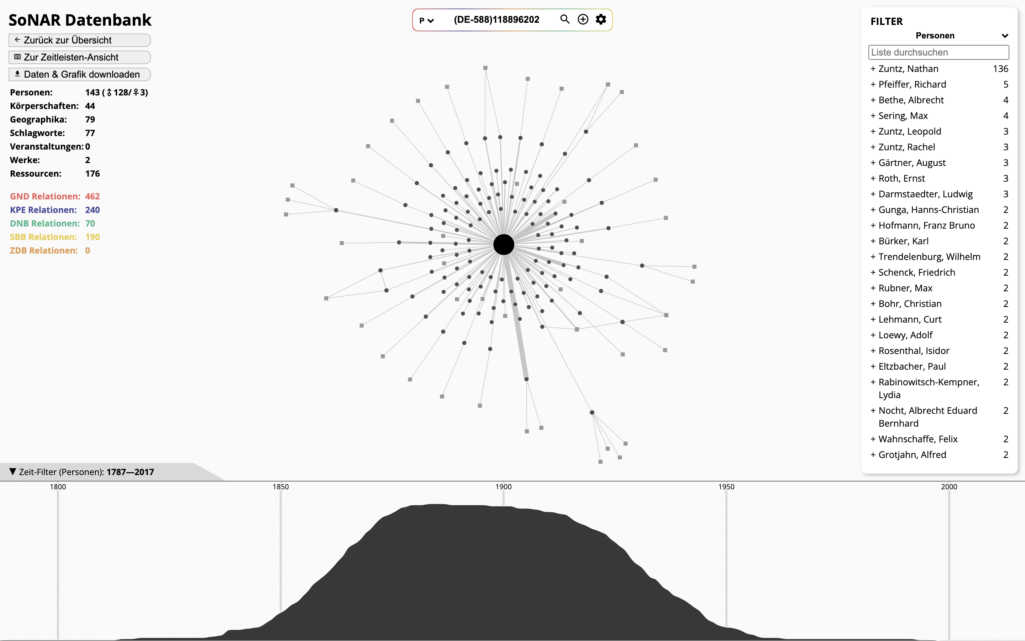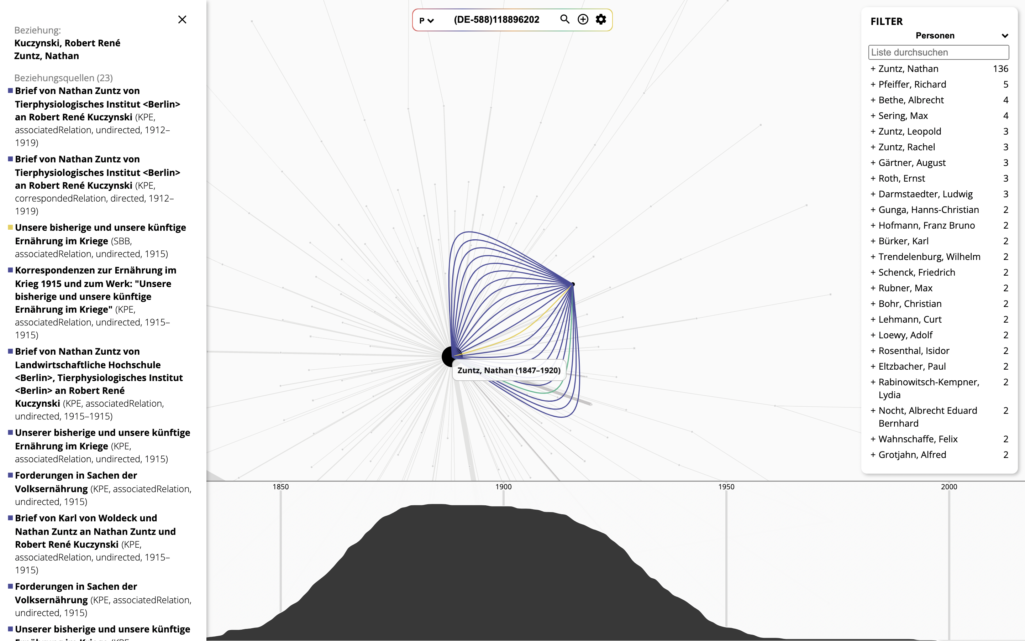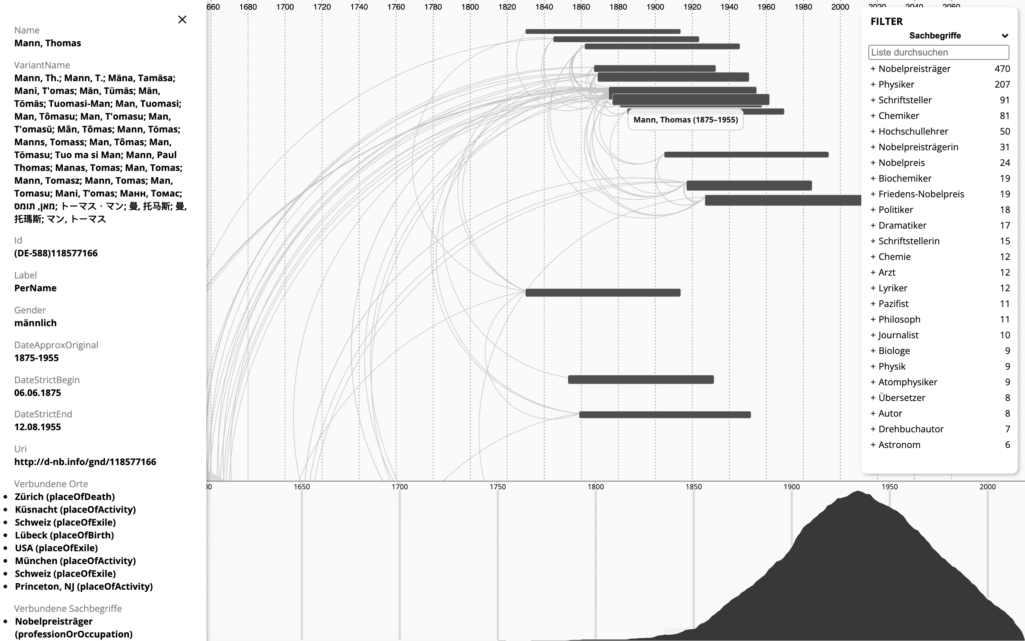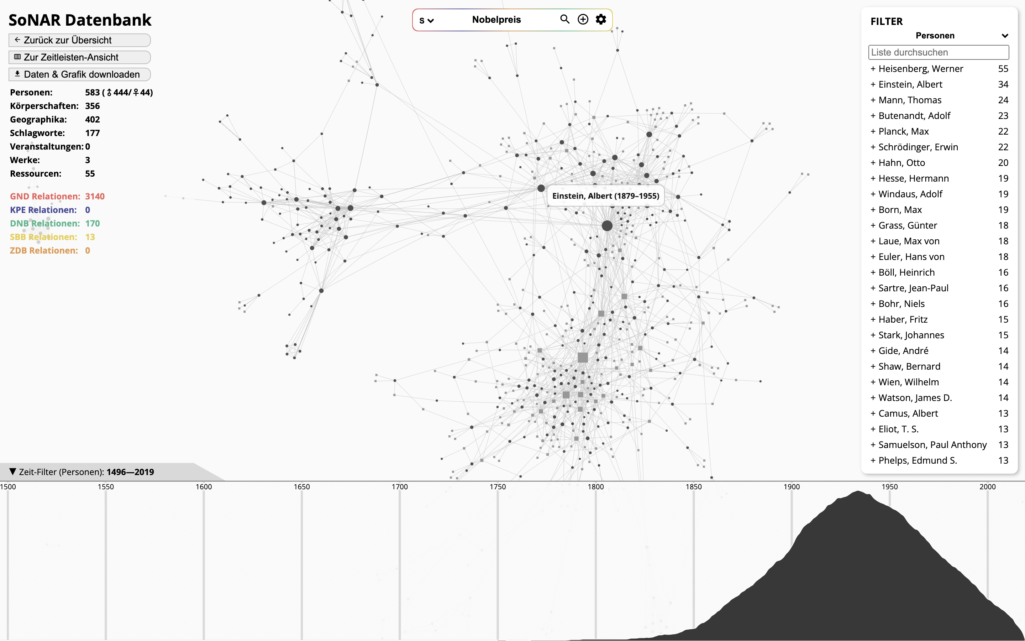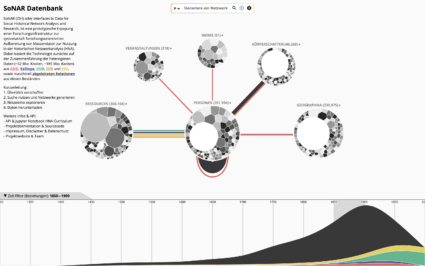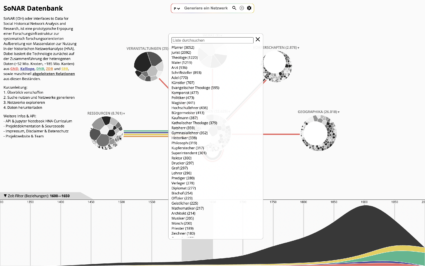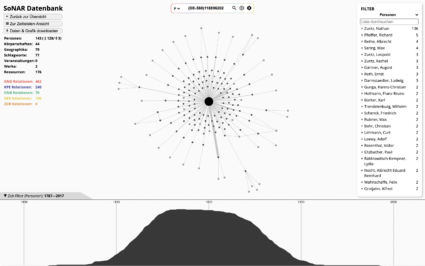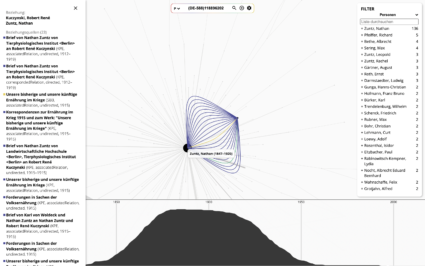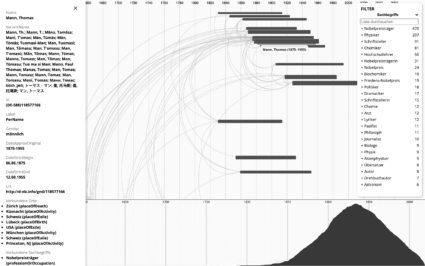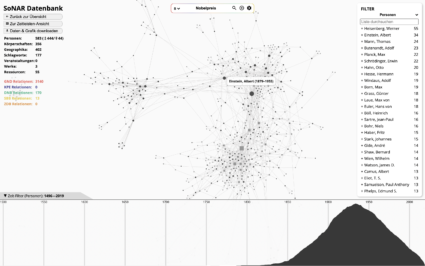Investigation and demonstration of research technology for historical network analysis. The project runs from July 2019 to July 2021 and is a cooperation between FH Potsdam (FHP/UCLAB), Humboldt Universität zu Berlin (HU), German Research Center for Artificial Intelligence (DFKI), Staatsbibliothek zu Berlin (SBB-PK) and Heinrich-Heine-Universität Düsseldorf (HHU).
The analysis of relationships between agents is key to understanding and explaining social phenomena. A lack of knowledge about the availability of suitable data, but also of relevant analysis technologies are frequently factors restraining the study of past events. In the last decades, cultural heritage organisations have produced an abundance of machine-readable data: (bibliographic and archival) metadata, full text collections, and sets of authority records contain multitudes of implicit and explicit statements about social relations.
SoNAR (IDH), Interfaces to Data for Historical Social Network Analysis and Research, will examine and evaluate approaches to build and operate an advanced research technology environment supporting Historical Network Analysis and related research. Project partners from various fields – historiography, information visualization, artificial intelligence and computer sciences as well as information science – work on this topic from their respective perspective.
The project will focus on particular aspects of the prospective research technology:
- Data preparation: creating automated methods of extracting entities and relations from bibliographic and archival metadata, full texts, and authority data (DFKI)
- Data management: ensuring the data complies with scientific requirements such as reproducibility of results, persistence of statements, and transparency of data provenance (DFKI)
- Research design: case-study based testing and evaluating of methods of Social Network Analysis with data prepared by promising components of the research technology (HHU)
- Visualization and interface design: an investigation of approaches to develop innovative concepts for interacting with data and visualizing graphs (FHP)
- Evaluation and quality assurance: analysing and evaluating the quality of (interim) results of work packages 1–4 (HU)
- Implementation: developing a concept for building and maintaining an adaptable research technology environment based on the results of work packages 1–5 (SBB-PK)
The role of the ᴜᴄʟᴀʙ comprises mainly the development of new visualization concepts/prototypes for explorative and descriptive analysis of the data, building on iterative ideation and prototyping processes in close collaboration with the other project partners.
Project partners:
Funded by:
This project is funded by German Research Foundation (DFG).
Publications
Associated Publications
—
Computer Graphics Forum (Proc. EuroVis). 42(3),
2023
Existing work on visualizing multivariate graphs is primarily concerned with representing the attributes of nodes. Even though edges are the constitutive elements of networks, there have been only few attempts to visualize attributes of edges. In this work, we focus on the critical importance of edge attributes for interpreting network visualizations and building trust in the underlying data. We propose 'unfolding of edges' as an interactive approach to integrate multivariate edge attributes dynamically into existing node-link diagrams. Unfolding edges is an in-situ approach that gradually transforms basic links into detailed representations of the associated edge attributes. This approach extends focus+context, semantic zoom, and animated transitions for network visualizations to accommodate edge details on-demand without cluttering the overall graph layout. We explore the design space for the unfolding of edges, which covers aspects of making space for the unfolding, of actually representing the edge context, and of navigating between edges. To demonstrate the utility of our approach, we present two case studies in the context of historical network analysis and computational social science. For these, web-based prototypes were implemented based on which we conducted interviews with domain experts. The experts' feedback suggests that the proposed unfolding of edges is a useful tool for exploring rich edge information of multivariate graphs.
Expand
—
Poster at Eurographics Conference on Visualization (EuroVis), Zurich (Switzerland),
2021
With this research (
→ poster version) we present an approach to network visualization that expands the capabilities for visual encoding and interactive exploration through edges in node-link diagrams. Compared to the various possibilities for visual and interactive properties of nodes, there are few techniques for interactive visualization of multivariate edge attributes in node-link diagrams. Visualization of edge attributes is oftentimes limited by occlusion and space issues of methods that globally encode attributes in a node-link diagram for all edges, not sufficiently exploiting the potential of interaction. Building up on existing techniques for edge encoding and interaction, we propose ‘Unfolding Edges’ as an exemplary use of an on-demand detail enhancing approach for exploration of multivariate edge attributes.
-
Mark-Jan Bludau
-
Thorsten Halling
-
Eva Maria Holly
-
Jasmin Wieloch
-
Hannes Schnaitter
-
Sandra Balck
-
Melina Plakidis
-
Georg Rehm
-
Heiner Fangerau
-
Marian Dörk
—
in: Konferenzband zur DHd2022: Kulturen des digitalen Gedächtnisses,
2022
Die Historische Netzwerkanalyse (HNA) hat sich zu einem etablierten Forschungsfeld entwickelt. Zu ihren wichtigsten methodischen Herausforderungen gehört die Suggestionskraft von Visualisierungen. Die Transparenz bezüglich der Datenquellen ist daher für die HNA sowohl bei selbst erhobenen als auch bei sekundär genutzten Daten Voraussetzung, will sie geisteswissenschaftlichen Kriterien der Nachprüfbarkeit und Nachvollziehbarkeit von Interpretationen erfüllen. Dieser Beitrag beschreibt und diskutiert – aufbauend auf einem iterativen und durch Workshops sowie einer Nutzer*innenstudie begleiteten Forschungsprozess – vier Designziele zur Verwirklichung einer solchen Transparenz: 1) Aufnahme und Kommunikation von Datenprovenienzen, 2) Dokumentation vorausgegangener Prozesse, 3) Offenhaltung der Interpretierbarkeit der Daten und 4) Unterstützung von Folgeforschung. Anschließend werden beispielhafte Umsetzungsstrategien in Form von Prototypen präsentiert.
Expand
—
in: Graph Technologies in the Humanities - Proceedings 2020. CEUR Workshop Proceedings (3110),
2022
Over the last decades, cultural heritage institutions have provided extensive machine-readable data, such as bibliographic and archival metadata, full-text collections, and authority records containing multitudes of implicit and explicit statements about the social relations between various types of entities. In this paper, we discuss how approaches to the creation and operation of advanced research infrastructure for historical network analysis (HNA) based on heterogeneous data sources from cultural heritage institutions can be examined and evaluated. Based on our interdisciplinary research, we describe challenges and strategies with a special focus on the issue of data processing, sketch out the advantages of human-centered project design in the form of a preliminary co-design workshop, and present an iterative approach to data visualization.
Expand
-
Mark-Jan Bludau
-
Marian Dörk
-
Thorsten Halling
-
Elena Leitner
-
Sina Menzel
-
Gerhard Müller
-
Vivien Petras
-
Georg Rehm
-
Clemens Neudecker
-
David Zellhöfer
-
Julian Moreno-Schneider
—
in: Konferenzband zur DHd 2020 Paderborn - Spielräume: Digital Humanities zwischen Modellierung und Interpretation,
2020
In diesem anwendungsbezogenen Forschungs- und Entwicklungsprojekt werden systematisch forschungsorientiert das Aufbereiten, Bereitstellen und Analysieren von Massendaten für den Aufbau einer Forschungstechnologie für die Historische Netzwerkanalyse (HNA), die als ein Zweig der SNA historische Fragestellungen untersucht, erprobt.
Expand

